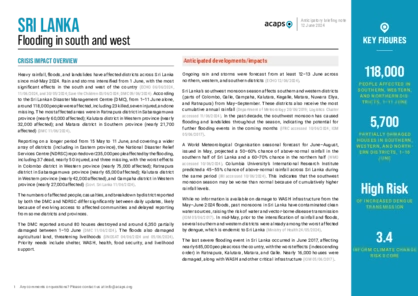Latest updates on country situation
24 June 2024
The southwest monsoon in Sri Lanka, which started in mid-May 2024 and intensified in early June, brought flash floods, mudslides, and strong winds in Central, Northwestern, Sabaragamuwa, Southern, and Western provinces. The most affected districts were Colombo, Galle, Gampaha, Kalutara, Matara, Puttalam, and Ratnapura. The natural hazards have affected around 250,000 people and resulted in around 77,000 needing humanitarian assistance. They require food, potable water, NFIs (such as essential clothing and sleeping mats), shelter repair assistance, livelihood support, WASH facilities and kits, healthcare support, and education supplies. The impact of the monsoon has damaged around 16,100 houses, destroyed 240, and damaged or destroyed crops, significantly affecting about 15,000 farmers’ livelihoods. Flash floods and mudslides have also destroyed or damaged essential household items and basic amenities, especially in the low-lying areas, and damaged WASH facilities, including sewerage lines and drinking water systems. (IFRC 20/06/2024, NDRSC 12/06/2024)
06 February 2024
Since October 2023, Sri Lanka has been facing heavy rainfall from the southwest and northeast monsoon seasons. The resulting floods and landslides have affected more than 420,000 people across the island. The worst affected districts are Ampara, Galle, Gampaha, Kilinochchi, Matara, Mullaitivu, and Puttalam. As at 31 January 2024, about 7,150 people in Ampara district were taking shelter in safety centres. The floods and landslides have damaged or destroyed houses, schools, WASH facilities (such as drinking water sources and sewerage lines), roads, power supply lines, and agricultural land. Destroyed land includes around 35,000 acres of paddy fields (25,000 in Ampara alone), severely affecting the livelihoods of 35,000 farmers. Around 95,000 people are estimated to need humanitarian assistance. They require shelter, food, potable water, livelihood support, WASH services, healthcare, and education assistance. (IFRC 23/01/2024, Govt. Sri Lanka 31/01/2024)
10 January 2024
As at October 2023, nearly 5.3 million people (24% of Sri Lanka’s households) were facing food insecurity. This is a 40% increase compared to March 2023 estimates. Around 60% of the households dependent on social assistance programmes, around 50% of households dependent on humanitarian assistance, and around 40% of unskilled agricultural labour faced moderate food insecurity. Agricultural producers also faced a significant deterioration in their food security situation compared to March 2023, which was Maha harvest season, reflecting the impact of the current agricultural lean season in the country. Over 50% of the households in the estate sector, comprising tea or rubber plantations, and around 25% of the rural sector faced moderate food insecurity. The consumption of inadequate diets among groups with increased vulnerability to the situation drives the deterioration in food security in the country, with the least consumed food groups being proteins, dairy products, and fruits. (WFP 29/12/2023, WB 04/04/2017, FAO 16/06/2023)
15 August 2023
A dry weather spell in Sri Lanka resulting from below-average rainfall in the first half of 2023 and water shortages in reservoirs have resulted in a drinking water shortage in 15 districts, affecting around 183,000 people. Local authorities have distributed drinking water to around 154,000 affected people. (ECHO 09/08/2023, NDRSC 15/08/2023)
current crises
in
Sri Lanka
These crises have been identified through the INFORM Severity Index, a tool for measuring and comparing the severity of humanitarian crises globally.
LKA007 - Cyclone Ditwah
Last updated 04/12/2025
Drivers
Cyclone
Crisis level
Country
Severity level
2.4 Medium
Access constraints
1.0
Analysis products
on
Sri Lanka
18 July 2022
Sri Lanka: Update on the socioeconomic crisis
DOCUMENT / PDF / 172 KB
On 10 June 2022, ACAPS published an anticipatory analysis of the prospects for the deterioration of the humanitarian situation in Sri Lanka. This report provides an update of the previous analysis with information available from 10 June to 17 July.
10 June 2022
Sri Lanka: Socioeconomic crisis
DOCUMENT / PDF / 266 KB
Sri Lanka faces an economic crisis partly resulting from its twin deficit economy. The economic crisis is affecting the daily life of the population. Hospitals have reported shortages of medicines, price increases have made food unaffordable for part of the population, and some people have already started to migrate to India to escape the effects of the crisis.
07 May 2020
Sri Lanka: Floods from Southwest Monsoon
DOCUMENT / PDF / 224 KB
The Southwest Monsoon is expected to arrive over Sri Lanka in mid to late May 2020. According to the National Department of Meteorology, an estimated 35,000 to 50,000 families may be displaced, based on analysis of previous floods and landslides.
16 August 2019
Sri Lanka: Drought
DOCUMENT / PDF / 637 KB
A rainfall deficit in the first half of the year has resulted in drought in most parts of Sri Lanka. As of 12 August, around 660,000 people have been affected across 18 districts. The worst affected districts are Batticaloa, Jaffna, Ampara, Mannar, Mullaitivu and Moneragala, with Mannar and Mullaitivu, both in Northern province, registering the highest percentages of affected people in their respective districts. Food and livelihood needs as well as WASH needs are reported. Farmer families in Northern province are particularly vulnerable.






